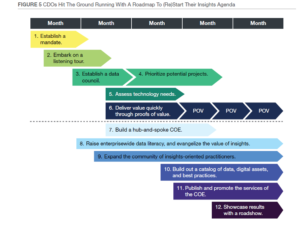
CDO: The Disrupter in Chief

(Sergey Nivens/Shutterstock)
“Disrupt, or be disrupted.” That’s the rallying cry of commerce in the 21st century, and big data is the materiel that battles will be fought with. Companies increasingly are turning to chief data officers (CDOs) to become the generals for defining and executing the big data strategies that will enable them to fight off disruptions, and become disrupters themselves.
Whether companies are playing offense or defense when it comes to digital transformation strategies, the common denominator is data. Data, in all its forms and manifestations, has become absolutely critical to the existence and success of companies.
As part of that ever-increasingly reliance on data to stay competitive, the CDO’s role has also evolved and expanded. In fact, according to Forrester principal analyst Jennifer Belissent, the CDO is now often responsible for data analytics.
“In many organizations, the [CDO] role has evolved to become more of a chief insights officer with purview over both data and analytics,” Belissent writes in “Chief Data Officers: Evolve Your Teams To Accelerate Impact From Data Insights,” which was published last week. “With a single role responsible for the entire data value chain, organizations can ensure an equilibrium in the supply and demand for data.”
Nearly two-thirds of companies now have a CDO (or somebody who’s role matches the CDO definition, even if their title does not), according to Forrester’s research. The firm also found that companies with a more mature “insights driven” approach (i.e. they are better at actually using data in practice versus just going with their gut or experience) are more likely to have a CDO compared to those at the beginning of their journey to become insight-driven.
In other words, the mere presence of a CDO is a good indicator that a company is on the right track. According to Forrester’s research, firms with CDOs are more likely to:
- Establish data literacy campaigns that encourage a culture of quantitative decision-making;
- Create data and analytics centers of excellence (COEs) or “hubs” with shared service teams;
- Adopt emerging technologies and best practices, like machine learning and agile data management;
- Deploy a cloud data analytics program;
- Found an enterprise-wide insights strategy.
Sean Knapp, the CEO and founder of Ascend.io, says 2021 will be a big year for CDOs. The next 12 months will be the “defining year” for the CDO, and go far in establishing whether the CDO role will go the route of a cost or a profit center.
“In years past, CDOs, and therefore the teams they direct and influence, have approached their position from a very technical and tactical mindset–operating primarily as a cost center for the enterprise as they lay a foundation for the future,” Knapp says. “However, as data becomes more intertwined with the fundamental success of the business, CDOs must refocus their efforts on strategy and transformation of how the business interacts with and benefits from data, rather than the technologies employed along the way.”
Two-Way Player
CDOs have multiple roles, including being a “gatekeeper” to data (and sometimes analytics). Making sure data is well managed, that regulations are adhered to, and that BI applications sitting atop the data are running well, are all CDO responsibilities. But just keeping the data lights on, so to speak, is selling the potential of the CDO role short.
In a Datanami column last year, Yasmeen Ahmad, Teradata’s vice president of strategy, hit the CDO nail on the head when she wrote:
“In certain circumstances, CDOs have been hired simply as ‘librarians’ to build a solid data foundation. These CDOs are tasked with activities such as infrastructure management, data cataloguing, master data management, data integration, data quality, security, and access. Such a narrow view on data and casting it as a sustaining activity, prevents the realization of the grander opportunities arising from the application of data. Leaving the rest of the organization to ‘figure it out’ and identify how the data foundation can be put to use and monetized often leads to the remainder of the transformative steps failing to complete.”
But it’s critical for a CDO to sometimes go on offense and seek more innovative uses of data–in other words, to be a disruptive force, she says.
“[M]aking a disruptive transformation requires a C-level player who won’t just play defense, but is ready to go on the offense, breaking through cultural and organizational inertia to define a new normal,” Ahmad writes.
Building to Success
How does a CDO go about doing this? Well, we turn once again to Forrester’s Belissent, who gave us some hints on how a CDO can achieve lasting success with another well-written report, this one titled “Chief Data Officers: Accelerate Insights-Driven Business Impact In 12 Steps.”
An “insights-driven culture” can mean a lot of things, but it’s clear that such a culture is a necessary pre-requisite for taking a disruptive approach to shaking up the company’s status quo. Most CDOs with a disruptive streak, therefore, will have already established an insights-driven culture in their organizations.
Belissent shared 12 key steps that a CDO might follow if she wants her company to become insight-driven. The first three steps involve the data team’s relationship with the rest of the company, including gaining support and a mandate from executive leadership; listening to partners within the business to find out what they want from analytics; and building a group, or a council to facilitate collaboration with constituents.
Data analytics projects start to get off the ground in steps four through six. Before building an enterprise architecture (step five), CDOs should establish the highest priority projects. Getting a few quick wins with easier projects will set the table for bigger things to come down the road.
As the analytics momentum starts to build, CDOs should look to start laying the foundation for long-term success, including: Building a COE; embarking upon data literacy campaigns; and expand the analytics community within their organization.
Steps 10 through 12 will help to keep the community going. These include: building a catalog of data and best practices; promoting the data and analytics services offered through the COE; and finally establishing the performance metrics based on business value.
As data becomes more central to a business’s success or failure, the pressure builds on CDOs to build a reliable and repeatable structure to generate insights from that data. These insights are critical not only to defend the company’s existing place in the marketplace, but also to establish new beachheads and to disrupt the competition in ways that are uniquely beneficial to the company’s strengths.
Related Items:
The CDO’s Role in Leading Data-Driven Transformation
The Emerging Role of the Chief Data Officer

































